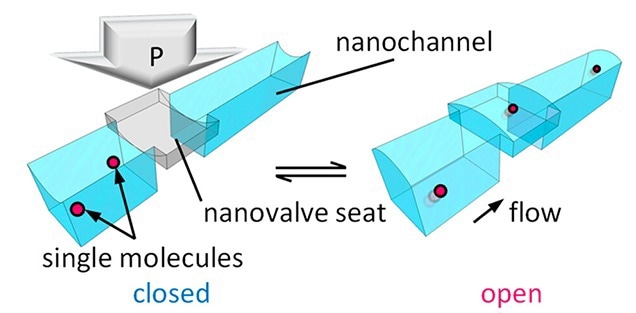Researchers dream of employing tiny molecules as building blocks, like how people construct things with mechanical parts. Nevertheless, molecules are extremely small—approximately one hundred millionth the size of a softball—and they travel aimlessly in liquids, leading to difficulty in manipulating them in a single form.
 Schematic drawing of the working principle of the single-molecule valve. Image Credit: Osaka Metropolitan University
Schematic drawing of the working principle of the single-molecule valve. Image Credit: Osaka Metropolitan University
To win over this difficulty, “nanofluidic devices” that can move molecules in very narrow channels, identical in size to one-millionth of a straw, are gaining attention as an approach to manipulating single molecules in solutions directly.
A collaborative study group headed by Associate Professor Yan Xu of the Osaka Metropolitan University Graduate School of Engineering has been efficient in managing the flow of single molecules in solution by closing and opening a nanovalve in a nanofluidic device by putting on external pressure.
The study group fabricated a nanofluidic device with a thin, flexible glass sheet on the top and a hard glass plate with small structures that make nanochannels and nanovalve seats on the bottom. They were successful in directly controlling and regulating the flow of individual molecules in solution. This was done by exerting external pressure on the flexible glass sheet to close and open the valve.
Also, they discovered that when they trapped single fluorescent molecules in the nanospace within the valve, the single molecules’ fluorescence turned brighter. This occurred because the small space turned harder for the single molecules to travel around aimlessly.
This effect of fluorescence signal amplification could help with detecting very small amounts of pathogens for early diagnosis of diseases such as cancers and Parkinson's disease, without requiring expensive equipment.
Associate Professor Yan Xu, Graduate School of Engineering, Osaka Metropolitan University
The results of this research could be an important step towards freely assembling materials with the use of single molecules as building blocks in solution. This technology can be valuable in different fields, like producing customized medicines for rare diseases and making better batteries and displays. There are limitless applications of it.
We have been addressing various challenges by proposing and promoting the concept of ‘Single-Molecule Regulated Chemistry (SMRC),’ where molecules are treated as building blocks and all processes involved in chemical and biochemical reactions in solution are performed on a single-molecule basis. The single-molecule valve marks the first step towards the goal, which could one day revolutionize chemistry, biology, and materials science, as well as transform various industries.
Associate Professor Yan Xu, Graduate School of Engineering, Osaka Metropolitan University
This research was partly funded by JSPS KAKENHI (Grant Nos. JP21H04640, JP20H00497, JP19KK0129, JP18H01848, JP26630403, and JP19J22901), MEXT KAKENHI (Grant Nos. JP21H05231 and JP19H04678), JST PRESTO (Grant No. JPMJPR18H5), JST CREST (Grant No. JPMJCR18H2), and SiMS of Osaka Prefecture University.
Journal Reference:
Hiroto Kawagishi, et al. (2023). Flexible Glass-Based Hybrid Nanofluidic Device to Enable the Active Regulation of Single-Molecule Flows. Nano Letters. doi.org/10.1021/acs.nanolett.2c04807.